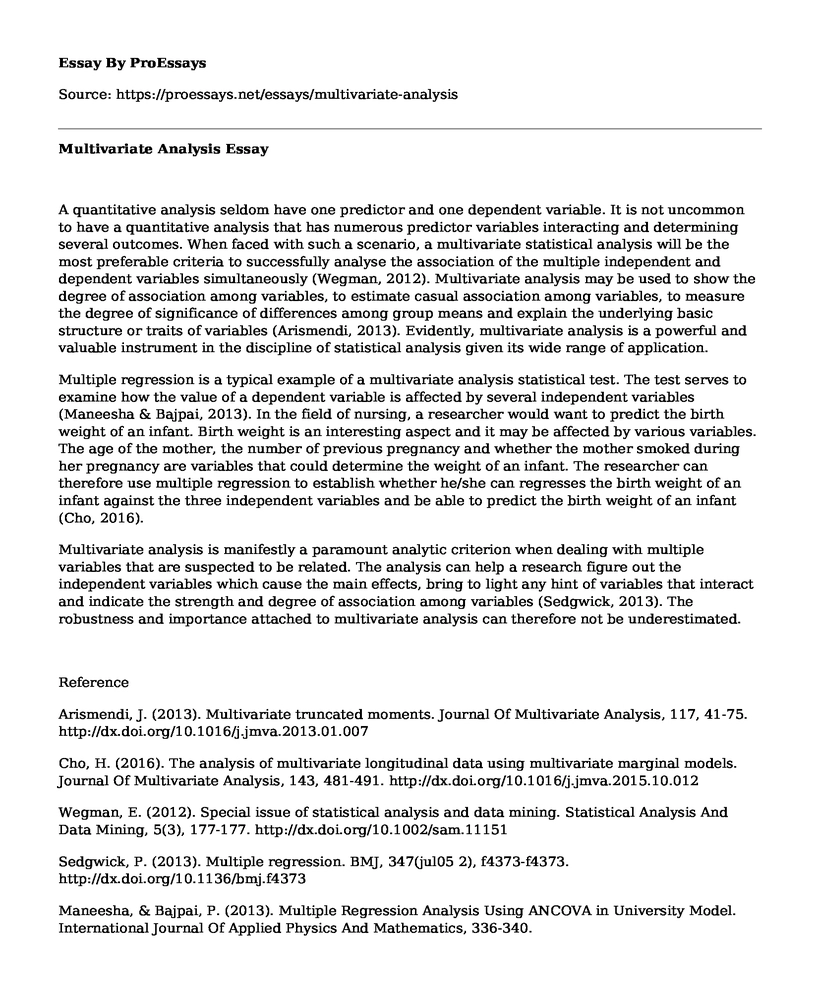A quantitative analysis seldom have one predictor and one dependent variable. It is not uncommon to have a quantitative analysis that has numerous predictor variables interacting and determining several outcomes. When faced with such a scenario, a multivariate statistical analysis will be the most preferable criteria to successfully analyse the association of the multiple independent and dependent variables simultaneously (Wegman, 2012). Multivariate analysis may be used to show the degree of association among variables, to estimate casual association among variables, to measure the degree of significance of differences among group means and explain the underlying basic structure or traits of variables (Arismendi, 2013). Evidently, multivariate analysis is a powerful and valuable instrument in the discipline of statistical analysis given its wide range of application.
Multiple regression is a typical example of a multivariate analysis statistical test. The test serves to examine how the value of a dependent variable is affected by several independent variables (Maneesha & Bajpai, 2013). In the field of nursing, a researcher would want to predict the birth weight of an infant. Birth weight is an interesting aspect and it may be affected by various variables. The age of the mother, the number of previous pregnancy and whether the mother smoked during her pregnancy are variables that could determine the weight of an infant. The researcher can therefore use multiple regression to establish whether he/she can regresses the birth weight of an infant against the three independent variables and be able to predict the birth weight of an infant (Cho, 2016).
Multivariate analysis is manifestly a paramount analytic criterion when dealing with multiple variables that are suspected to be related. The analysis can help a research figure out the independent variables which cause the main effects, bring to light any hint of variables that interact and indicate the strength and degree of association among variables (Sedgwick, 2013). The robustness and importance attached to multivariate analysis can therefore not be underestimated.
Reference
Arismendi, J. (2013). Multivariate truncated moments. Journal Of Multivariate Analysis, 117, 41-75. http://dx.doi.org/10.1016/j.jmva.2013.01.007
Cho, H. (2016). The analysis of multivariate longitudinal data using multivariate marginal models. Journal Of Multivariate Analysis, 143, 481-491. http://dx.doi.org/10.1016/j.jmva.2015.10.012
Wegman, E. (2012). Special issue of statistical analysis and data mining. Statistical Analysis And Data Mining, 5(3), 177-177. http://dx.doi.org/10.1002/sam.11151
Sedgwick, P. (2013). Multiple regression. BMJ, 347(jul05 2), f4373-f4373. http://dx.doi.org/10.1136/bmj.f4373
Maneesha, & Bajpai, P. (2013). Multiple Regression Analysis Using ANCOVA in University Model. International Journal Of Applied Physics And Mathematics, 336-340. http://dx.doi.org/10.7763/ijapm.2013.v3.232
Cite this page
Multivariate Analysis. (2021, Mar 14). Retrieved from https://proessays.net/essays/multivariate-analysis
If you are the original author of this essay and no longer wish to have it published on the ProEssays website, please click below to request its removal:
- Multivariate Analysis
- Essay Sample on White Collar Crime
- Essay Sample on Data Visualization: A Vital Tool for Statistics Experts
- Essay Example on Clinic's Total Profit Margin & Net Income: $1.5M
- Essay Example on Target's Data Security: Ensuring Trust and Safety
- Essay Example on Policy Measures to Protect Working-Class Group from Tuberculosis
- Paper Example: International Disaster Risk Factors







